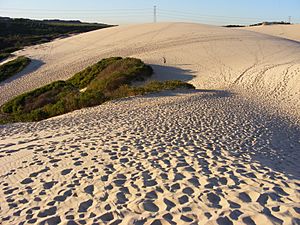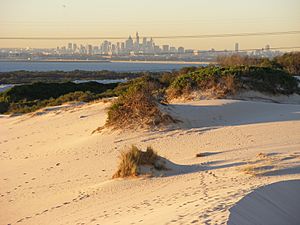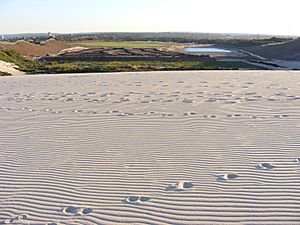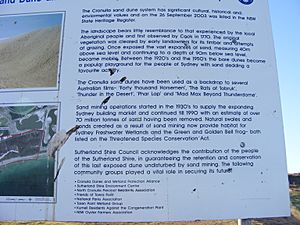Cronulla sand dunes facts for kids
Quick facts for kids Cronulla sand dunes |
|
|---|---|

The Cronulla sand dunes, pictured in 2007
|
|
| Location | Lindum Road, Kurnell, Sutherland Shire, New South Wales, Australia |
| Official name: Cronulla Sand Dune and Wanda Beach Coastal Landscape; Part of Kurnell Peninsula Headland; Cronulla Sand Hill | |
| Type | State heritage (landscape) |
| Designated | 26 September 2003 |
| Reference no. | 1668 |
| Type | Coastal environment |
| Category | Landscape - Natural |
| Lua error in Module:Location_map at line 420: attempt to index field 'wikibase' (a nil value). | |
The Cronulla sand dunes are a special natural area in Kurnell, Australia. They are also known as the Cronulla Sand Dune and Wanda Beach Coastal Landscape. These dunes are important for their history, nature, and cultural meaning. They have been used for many things over time, like mining sand, filming movies, and as a fun place to visit. Today, they are protected for nature and are a popular spot for people to enjoy. The dunes are part of the New South Wales State Heritage Register, which means they are officially recognized as a significant place.
Contents
History of the Cronulla Sand Dunes
The Cronulla sand dunes are very old, about 15,000 years old! They formed when the sea level settled. Rivers used to flow through this area, making Kurnell an island. Over time, sand and dirt blocked these rivers. This created a natural bridge, called a tombolo, connecting Kurnell to the Cronulla mainland.
Aboriginal Culture and the Dunes
The sand dunes are very important to the Gweagal people, who are the traditional owners of this land. They have lived here for thousands of years. The dunes hold many signs of their history, like carvings, special ceremonial places, and middens (piles of shells from old meals).
Many other sand hills where Aboriginal people lived have disappeared. But because these dunes move and drift, many ancient sites have been covered and kept safe. This makes the Cronulla dunes very special to the Aboriginal community.
The Gweagal people were part of the Tharawal (or Dharawal) tribe. They lived between the Cooks and Georges Rivers. They were skilled at fishing from canoes and the shore. They also hunted animals like possums and goannas. The area had plenty of food, so they did not need to move around as much as other Aboriginal groups.
The Gweagal people were also the guardians of sacred white clay pits. This clay was very important. They used it to line their canoes for fires and as body paint. They also mixed it with berries to make bright colors for ceremonies. Sometimes, they even ate it as medicine. Today, Tharawal people still live near the dunes and share their traditional art and culture.
European Settlement and Changes to the Land
In 1770, Captain James Cook landed in Botany Bay, near what is now Silver Beach. He looked at the sand hills, but they were covered in plants back then. Cook stayed for eight days, collecting plants and mapping the area. He thought the land would be good for farming.
Later, in 1788, Captain Arthur Phillip arrived with the First Fleet. They tried to settle here but found the land was not good enough. They soon moved to Port Jackson (Sydney Harbour).
Less than 100 years after Cook's visit, much of the original plant life was gone. Trees were cut down or destroyed. Thomas Holt, who owned most of the land, tried to farm sheep. But this did not work well. He cleared more trees, which led to thorny bushes growing instead. By 1868, most of the forests were cut down for building houses and bridges.
The first land grant was given in 1815 to James Birnie. Later, John Connell gained ownership of the Kurnell Peninsula. His grandsons, Elias and John Laycock, started cutting down timber in 1835. They even built a canal to float logs to Sydney.
In 1861, Thomas Holt bought the entire estate. He owned a huge amount of land, about 13,000 acres. He tried to graze sheep and then cattle. But the land was not good for this. When the trees were gone, the cattle ate the grass that held the sand in place. This made the sand dunes unstable. The dunes began to move about 8 meters each year! This clearing of land created the distinctive Cronulla sand dunes we see today.
How the Area Grew from the 1880s
In 1885, a train line opened, making it easier for people from Sydney to visit. Soon, Cronulla became a popular place for seaside holidays. By the 1920s, the sand dunes were known for their vast, bare stretches of sand. They became a popular playground for children, who would enjoy activities like sandboarding.
The unique, desert-like look of the dunes also attracted filmmakers. In 1941, the movie Forty Thousand Horsemen was filmed here. Many other Australian movies, like The Rats of Tobruk and Mad Max Beyond Thunderdome, also used the dunes as a backdrop.
Sand Mining and Its Impact
In the 1930s, the Holt family started mining sand from the dunes. This sand was used for building in Sydney. This continued until 1990. It is estimated that over 70 million tonnes of sand were removed!
The sand was valuable because it had a lot of crushed shells and was very clean. But removing so much sand made the peninsula weaker against storms. Ocean waves now threaten to break through into Botany Bay during big storms. Today, only a few parts of the original dunes remain. The areas where sand was removed are now deep, water-filled pits.
Oil Refinery and Further Changes
In 1951, the Caltex Oil Company wanted to build an oil refinery at Kurnell. At first, there were protests from environmental groups. But the refinery, called the Australian Oil Refinery Company, opened in 1954. This refinery was the largest industry on the peninsula.
The removal of sand for building continued, and the refinery, once hidden by tall dunes, became visible from Cronulla. The area became much more industrial.
Modern Development and Conservation
Even today, there are ongoing discussions about development on the Kurnell Peninsula. In 2004, a large housing development was approved near Wanda Beach. This caused concern among locals and environmental groups.
One big concern was the impact on the endangered Green and Golden Bell Frog. These frogs live in the water-filled ponds created by sand mining. These ponds are now important breeding grounds for them.
The local council wanted the area to be used for tourism, nature protection, and heritage. In 2010, a new plan was approved for housing and community sports fields. This plan included using recycled water for homes and fields.
The Cronulla dunes have been protected because of their importance. The last remaining undisturbed dune, called the H2 dune, is especially important. It might hold archaeological evidence of Aboriginal life, like shell middens or tools. It is also a key habitat for the Green and Golden Bell Frog.
Why are the Cronulla Sand Dunes Special?
The Cronulla Sand Dune, Lucas Reserve, and Wanda Beach are important for many reasons:
- History and Culture: They show how the land has changed since Captain Cook first landed in 1770. They are also very important to the Aboriginal community, especially the La Perouse Aboriginal community, who are descendants of the first people Cook met.
- Changing Landscape: The dunes show how European farming and logging completely changed the natural environment.
- Film Location: The vast dunes were used as a desert backdrop for famous Australian movies like Forty Thousand Horsemen and Mad Max Beyond Thunderdome.
- Recreation: Since the late 1800s, the dunes and beaches have been a popular place for people to relax and have fun. People enjoyed sand sledding, hang gliding, and horse riding.
- Nature and Wildlife: The ponds formed by sand mining are now vital breeding grounds for the endangered Green and Golden Bell Frog.
- Community Spirit: The local community has worked hard for many years to protect the dunes from further sand mining and development. This shows how much people value this unique place.
- Unique Landmark: The Cronulla Sand Dune is the last large, undisturbed dune in an area that once had a massive dune system. It stands out as a significant landmark.
Geology of the Dunes
The Kurnell Peninsula is made up of bedrock and a sand spit. The sand dunes here are called "transgressive barrier dunes." This means they have moved north over time from Bate Bay. Even though most of the plants have been cleared, some dry sclerophyll woodland still remains.
Fitness Training at the Dunes
The Cronulla sandhills are a popular spot for athletes to train. Both amateur and professional athletes come here to push themselves. They do tough soft-sand conditioning sessions to stay fit or prepare for sports like rugby league, rugby union, cricket, soccer, and boxing.
The sandhills have steep slopes, some over 45 degrees. Athletes do hour-long sprint sessions, which is hard aerobic training. It is also great for leg strength without putting too much stress on knees and ankles. Famous cricketers like Glenn McGrath, Michael Clarke, Ricky Ponting, Brett Lee, and Brad Haddin have trained here. Boxer Anthony Mundine also used the sandhills to prepare for fights.
Images for kids








